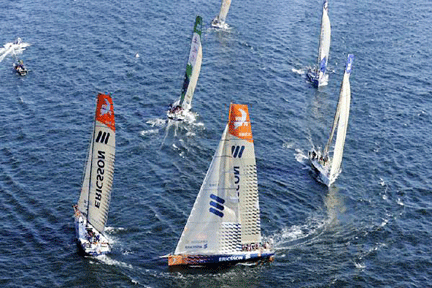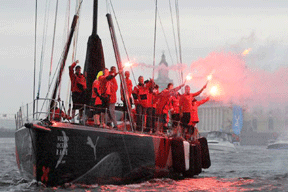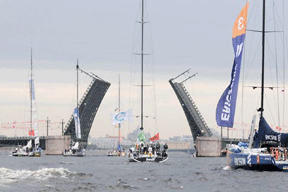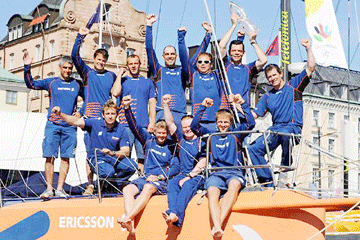
Volume XVII, Issue 28 # July 9 - July 15, 2009 |
 |
Round the World in 87 Days
The 2009 Volvo Ocean Race ends in St. Petersburg, Russia
by Steve Carr
 |
The fleet rounds the mark, left, at the start of Leg 10 from Stockholm to St Petersburg. |
After sailing more than 37,000 miles, covering five continents with stops at 11 ports in 10 countries, the Volvo Ocean Race came to an emotional end in St. Petersburg, Russia.
Kosatka or Killer Whale tried to steal the show by announcing Team Russia would be resuming the race on the final leg, after dropping out in Singapore last Christmas because of financial problems. But in the end, Team Russia was unable to pass the measurement and rules requirements and was not allowed back in by the Volvo Race Committee.
Team founder Oleg Zherebtsov then went to Plan B: “Our intentions are to go to the start line together with the other seven yachts competing in the Volvo Ocean Race from where we will shadow the fleet in racing mode all the way to the finish line and to the final mooring spot with all other VOR yachts in front of St. Peter and St. Paul Island,” he said.
 |
The Puma crew light flares in the final run down the Neva River to the finish parade, above. |
Ericsson 4 had already clinched the overall race, so this last leg was about second place. PUMA had a 61⁄2-point lead over Telefonica Blue with seven points still in play. So if PUMA exploded before the start and T-Blue took first, then pigs would fly from the treetops and — you get the point.
For that final leg there was nothing at stake except bragging rights, and most folks were rooting for one of the other boats — Delta Lloyd, Green Dragon or Telefonica Black.
The Last Leg
The 400-mile burn-run began in steady winds on yet another sunny day as the fleet left Stockholm for a straight-forward race across the Baltic Sea and down the Gulf of Finland. The crews were looking at about a 40-hour trip.
That’s not to say there weren’t plenty of lighthouses, shoals, shipping lanes, windmills, navigation marks and exclusion zones to avoid along the way. Still, tactics were going to take a back seat to crew performance, boat speed and luck. It was like racing sailing rockets from Havre de Grace to Virginia Beach and back.
As usual, T-Blue, PUMA and E-4 got the best start. The others split off and sailed a less direct but faster wind angle relative to the leaders. As the boats blasted east on port tack, it became clear that the wind shifts were going to rule the day.
The wind began rotating to the east as the fleet converged on the waypoint at the entrance to the Gulf of Finland with their masthead genoas unfurled. It was upwind sailing in a moderate chop while the temperature started to plummet.
 |
The bridges along St. Petersburg’s Neva River were raised for the fleet to celebrate the race’s end. |
Nearing the coast of Estonia, Telefonica Black tacked to starboard. The rest of the fleet followed like synchronized swimmers.
With the sun setting on the first day of racing, Ericsson 3’s Gustav Morin checked in. “Again we have a very intense race going on,” he wrote. “We still have everyone more or less in sight, but the big fight has since the start been between PUMA, Telefonica Blue, Ericsson 4 and us.”
Entering the 35-mile-wide Gulf of Finland, the fleet separated, with most of the boats taking a more southerly course while Telefonica Black and PUMA steered down the middle. The wind shifts required the boats to tack and stack as they headed east. With the white nights of the northern latitudes in play, the crews were able to grab the occasional cat nap on deck.
The Race Committee had established a special exclusion zone near the island of Moschnyy. No one knew exactly why, though the charts indicated minefields in the area. The boats obediently tacked north to steer clear.
Then the Race Committee dealt its last hole card, announcing the course would be lengthened with a 30-mile triangle course just to the east of the exclusion zone. As in Stockholm, the finish line was hours from the dock. The boats were going to have to motor in and clear customs. Folks in St. Petersburg were planning a gala welcome with several Neva River bridges raised simultaneously at 5pm local time. The extra miles of racing timed the fleet to arrive on schedule.
 |
The Ericsson 4 team celebrate victory in the 2008-09 Volvo Ocean Race. |
E-mails from PUMA quickly followed. They were in the lead. Adding an extra race within a race would give the trailing boats a chance to catch up, especially if the wind dropped as forecasted.
“As you can imagine, this is universally unpopular with the guys who just want to finish,” groaned Rick Deppe aboard PUMA. “Everyone is feeling a little burned out.”
Telefonica Black and PUMA then began an epic battle around the buoys toward the finish, tacking relentlessly, trying to take advantage of the other’s mistakes as they sailed within meters of one another. It was light-wind sailing, and the Telefonica boats have always excelled in those conditions.
The lead changed several times, but in the end, boat design won out. Telefonica Black snagged a first leg victory. PUMA finished a minute later, followed shortly by Telefonica Blue.
* * * * *
After 87 days of racing round the world, the leaders’ point spread looked like this: Ericsson 4, 1141⁄2; PUMA, 1051⁄2; Telefonica Blue, 98.
It’s been a great ride, and I hope you all enjoyed it as much as I did. Special thanks to the media lads aboard each boat, who brought us the spectacular photos of the race, along with Mark Chisnell, Cameron Kelleher, Riath Al-Samarrai and Peter Rusch, who brought us their exciting daily reports and stories.
See you in 2011 for the next Volvo Ocean Race. I wonder if they will be stopping in Annapolis …